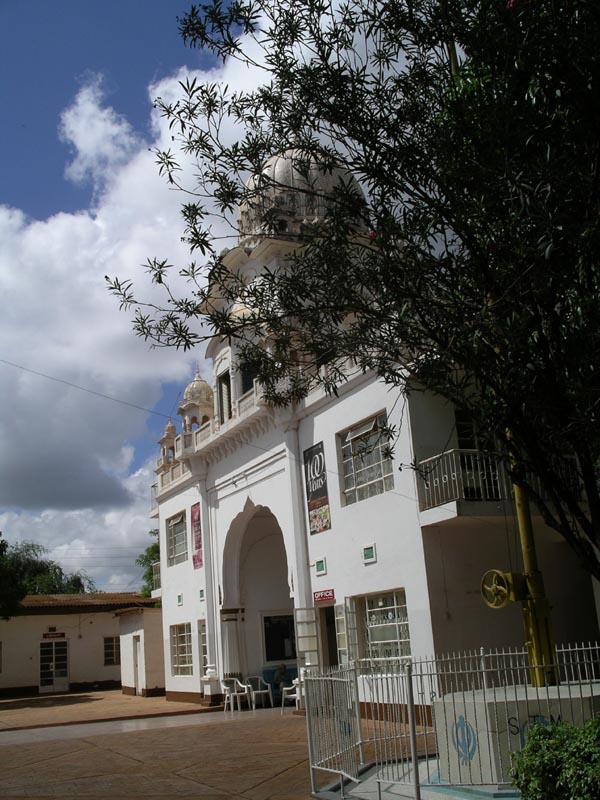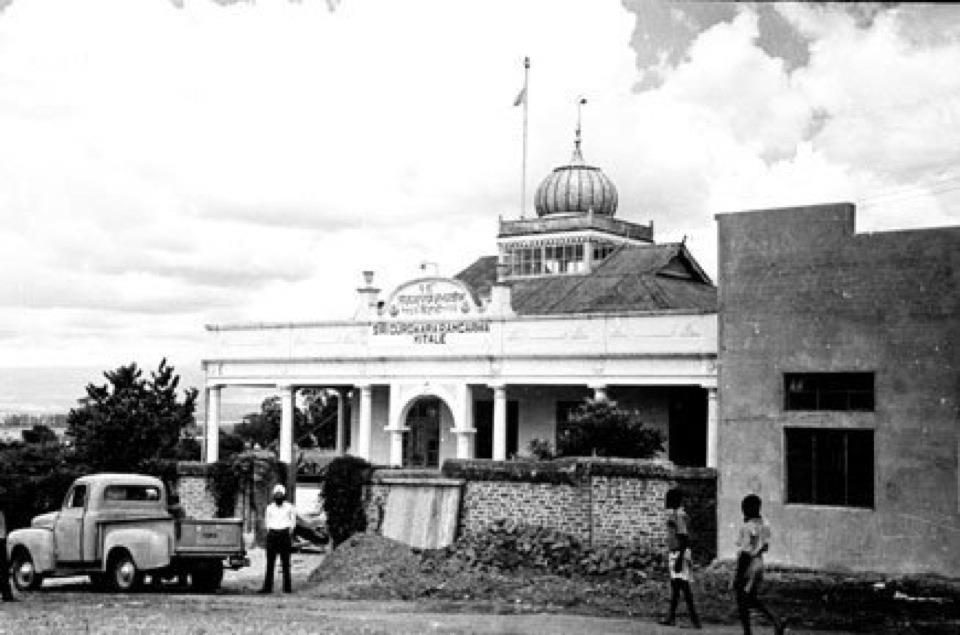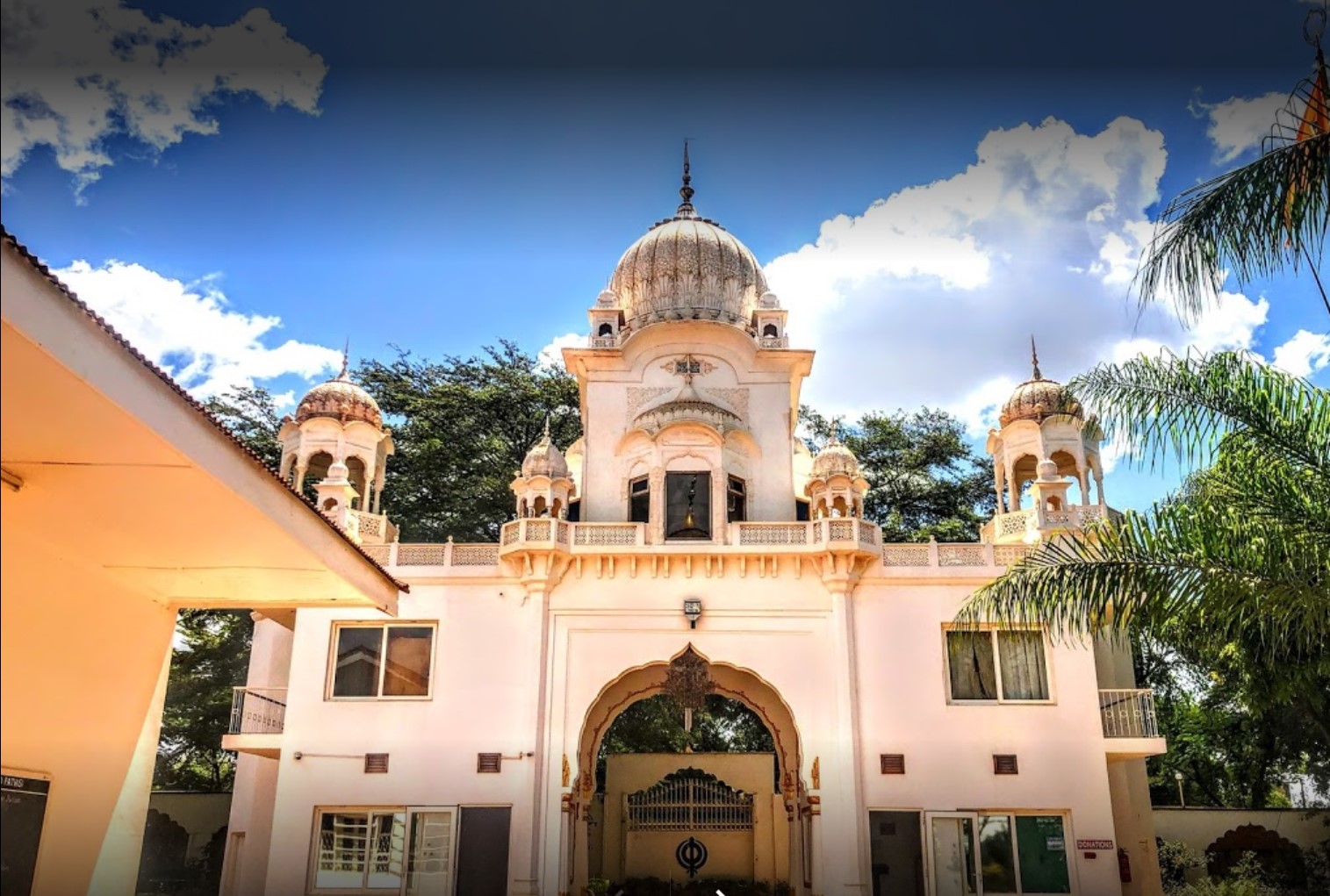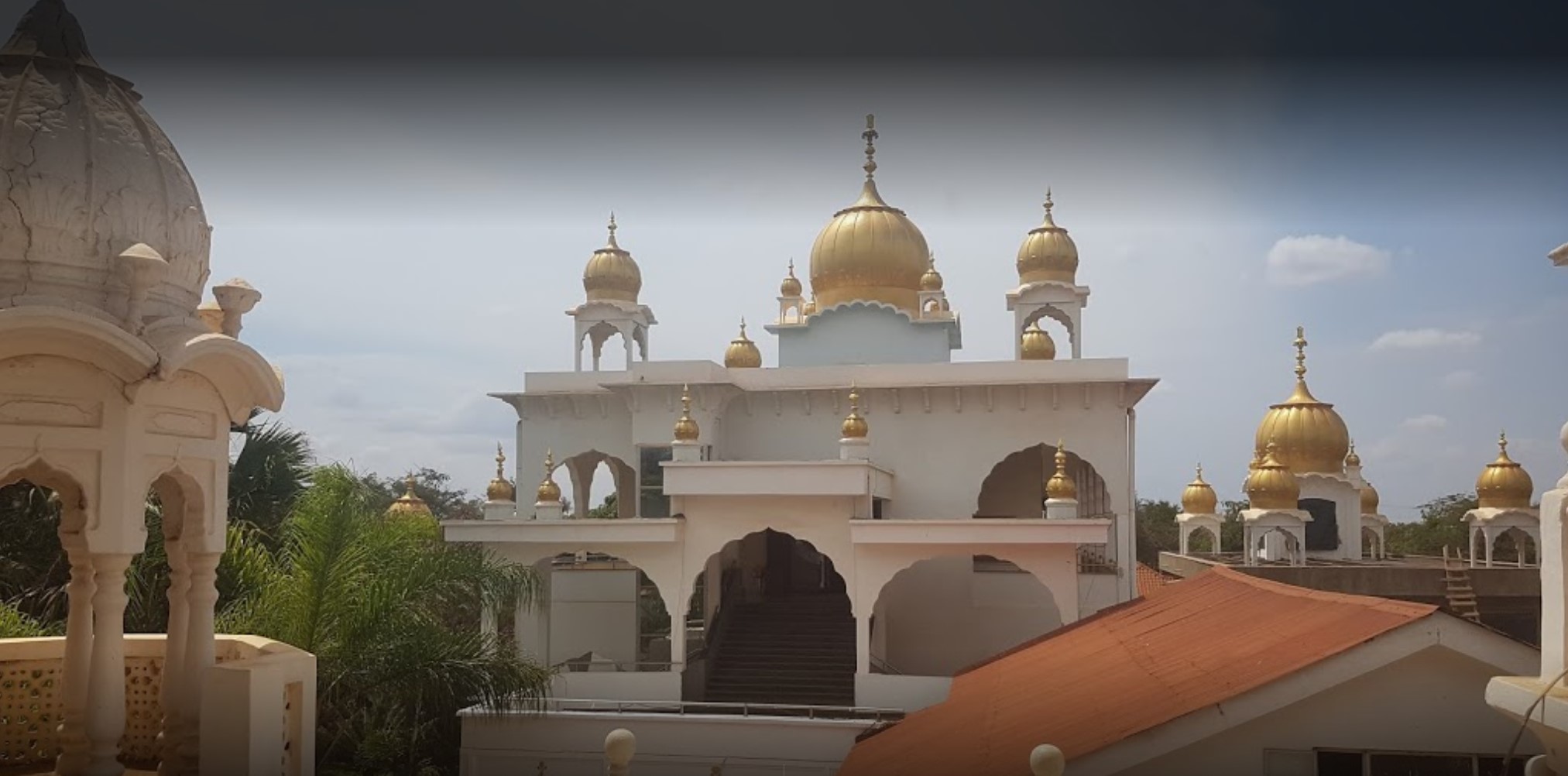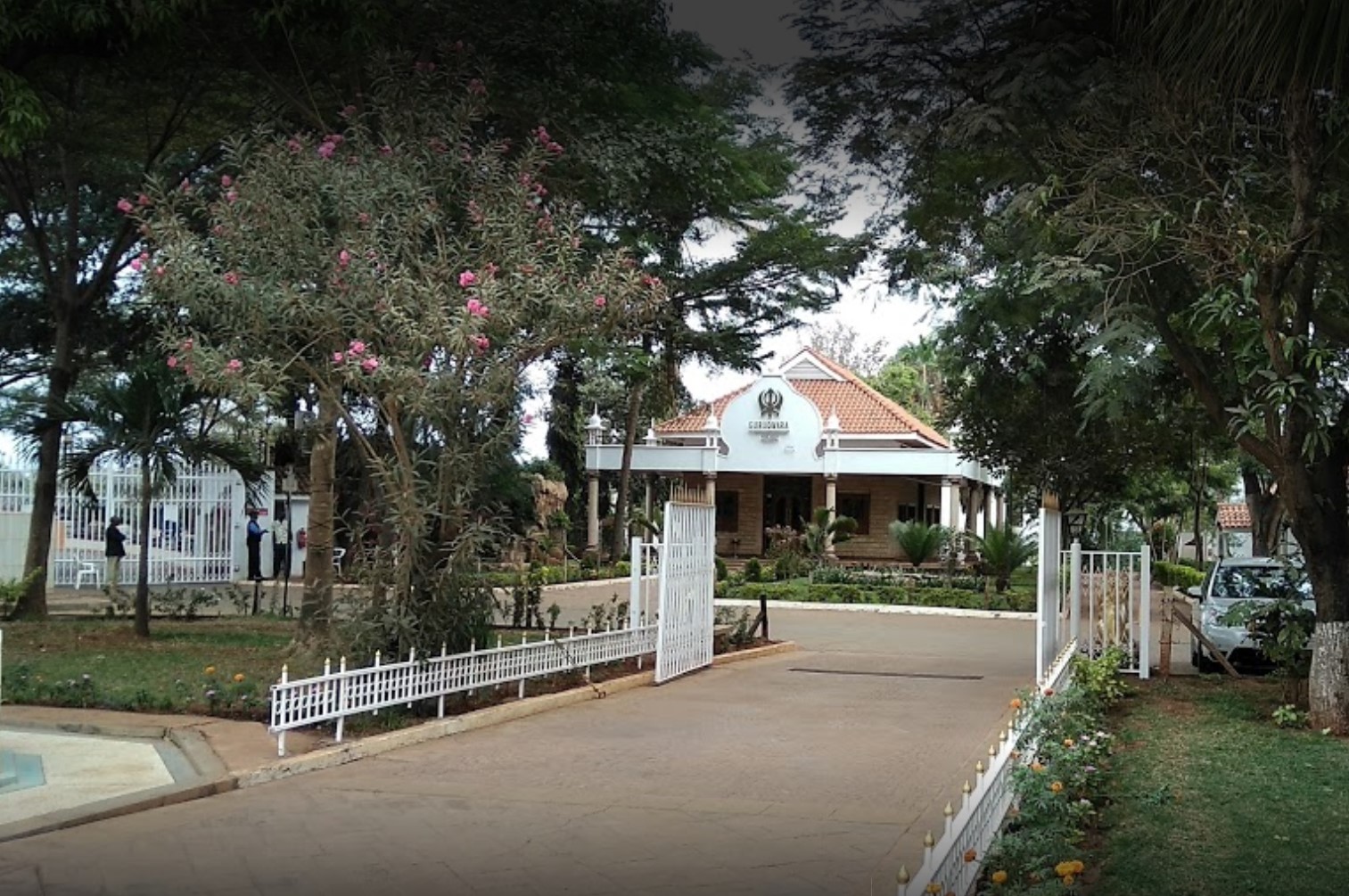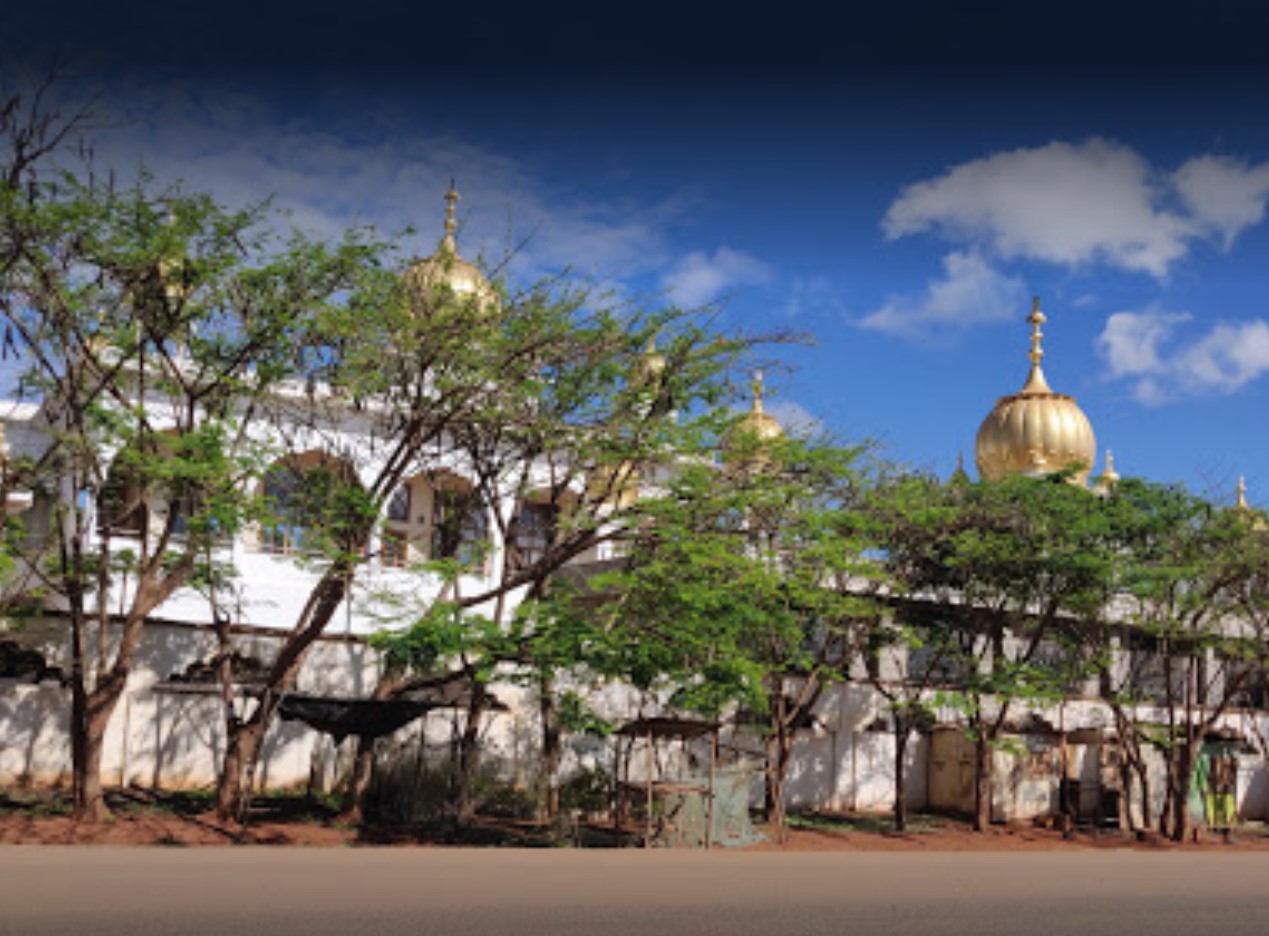Makindu Sikh Temple
Sikh Temple Makindu is located about 100 miles (160km) from Nairobi on the main Nairobi to Mombasa Road. It was built in 1926 by the Sikhs who were working on the construction of the railway line from the coast (Mombasa) inland to Lake Victoria and beyond to Uganda. Today, all types of people visit this Gurdwara everyday and it is a ‘must-see’ Gurdwara for any Sikh travelling to Kenya and East Africa. It provides a peaceful atmosphere where one can meditate and calm ones mind before proceeding to join the “rat-race” again.
The Gurdwara complex is very large and has facilities for langar around the clock and living accommodation for travellers. Set in the forest off the main road, the Makindu Gurdwara is the only convenient rest stop for weary motorists on this busy and long road to and from Mombasa. So the Sikh community of Kenya have done something special. They have built a beautiful edifice and campus where anyone of any religion or of no religion can withdraw from the mundane and reflect on the spiritual. This large complex houses a huge dining facility which provides free langar 24 hours a day as determined by their founder Guru, Guru Nanak Dev. Rooms with beds – several with attached bathrooms – are available for tourists to stay for up to two nights.
Everyone in Kenya seems to know of it and most tourists stay to rest and eat. Most are non-Sikhs. There is no charge for this service, but most people donate to the Gurdwara. Apparently it is run by a consortium of the Nairobi Gurdwaras. The aura at Makindu would calm the most tormented mind; one automatically drifts away from the mundane and towards the spiritual and peaceful.Makindu Gurdwara Background Sikh Temple Makindu was built in 1926, though its roots are believed to have been present way before then. When the Uganda Railway was completed in 1902 at Port Florence (which is now Kisumu, Kenya), Makindu played a prominent role as a service point on the railway’s advance from Mombasa. Dozens of artisans and train drivers were Sikhs and the station at Makindu became a place of religious fervour. Sikhs, Hindus and Muslims would gather together in the evenings and sing the praises of God. They did so under a tree, the spot where the current Gurudwara now stands. It is also believed that the Gurudwara was funded by non-Sikhs along with Sikhs. In the years before 1926, the Gurudwara was a tin-roof little hut where the Sikhs used to pray everyday, and the Guru Guru Granth Sahib was housed there. But when the Railway moved on from Makindu, the service point went into disuse and became unimportant. The Sikhs naturally moved along too, leaving the tiny Gurudwara behind, under the watchful eye of an African servant who would clean the Gurudwara. Sikh Devotees who passed along the Gurudwara would leave offerings of money by dropping it through the locked Gurudwara’s window. History
As the years rolled on and the Railway complete, the Sikhs settled in Kenya. Slowly, they began to contemplate the idea of reviving the small Gurudwara in Makindu. Akhand Paaths began to be organised on regular weekends, with families travelling 200 miles or so, in rough murram red-soil earth. There, they would gather and pray, prepare langar and socialise. Over the years, the Gurudwara began to be Developed. It is in 1926 that a solid foundation was laid. The Gurudwara then became a fully-functional one – with a langar hall, prayer hall and tiny rooms of accommodation for the gyanis and sevadaars of the Gurudwara. It also began to provide free food and rest for weary travellers who would stop by at the Gurudwara for a night or two on their journeys to and from Nairobi and Mombasa. Legend have been connected to this magnificent Gurudwara.
It has truly been referred to as the ‘Harmandir Sahib’ of Africa. It is so amazing that even now, as i pen these lines, an electric current runs through me, just thinking about the power of that Gurudwara. A copy of the Guru Granth Sahib that survived a mysterious fire which burnt down the whole Gurudwara (probably before 1926) is still there today. I was fortunate to obtain the darshan of the Guru Granth Sahib at a Sikh’s residence in Mombasa. On it’s first page, the then – Granthi of the Gurudwara recorded, in his own handwriting, exactly what had happened that day, and how miraculously, the Guru Granth Sahib was untouched by the tragedy to the Gurudwara. Miracles? An African sevadar of the Gurudwara once claimed that he saw, in the night awoken from his sleep, a figure on a white horse. The horseman approached him and spoke to him, telling him not to speak to anyone about the incident of his visit. The startled and shaken man could not believe his eyes and was so scared that he he told the first person he saw the following morning. Asked who the man on the horse was, the African man pointed to a painting of Guru Gobind Singh which was displayed in the Gurudwara and said, ‘That was him! Exactly like the was is there and so was the white horse!’
The incident spread through the Sikh community like wild fire and soon people began to come more often to the Gurudwara, regardless of the miles that separated them from it. The incident also prompted the Sant Baba Puran Singh Kerichowale (founder, Guru Nanak Nishkam Sewak Jatha) to lead Gursikhs to gather at the Gurudwara regularly, and serve it by prayer, langar and cleaning. The Gurudwara had been almost forgotten and neglected when Guru Gobind Singh’s incident occurred. That was not the only incident of the darshan of Guru Gobind Singh at Makindu Sahib. People claim to have have heard, in the silent of night, to have heard the approach of horses, just outside the Gurudwara. The sounds were akin to an army, stopping for the night. They claimed that they heard sounds of a kitchen being put in place, like langar was being prepared. Evidently, the incident was believed to be another darshan of the Guru, stopping by the Shrine. In yet another event, an amazing first-time encounter happened with a member of the Istri Sabha during the early years of the Gurudwara. A lady who was reading the Guru Granth Sahib in the night, lit by only a kerosene lamp (there was no electricity there then), witnessed in the shadow falling on the Guru Granth Sahib. The figure, she recalled, was of someone doing the ‘chaur’ over the Sikh Scriptures. The figure was, by description, none other than Guru Gobind Singh. Most Unique and beautiful The Gurudwara today is among one of the most unique and beautiful ones outside India. Sikhs and non-Sikhs alike describe the same feeling when they step into the Gurudwara – that of peace. It is an indescribable peace and bliss. A aging European stranger i met at an art exhibition just the other day, began talking to me about the Gurudwara when she saw me wearing a branded jacket of the Gurudwara. ‘Oh, I’ve been there,’ she told me, ‘a beautiful temple, i must say.’ She explained how a decade ago, she had stopped there for the night on her journey from Mombasa back to Nairobi, and said she had never felt so peaceful in her life before. She even felt the presence of someone seated in the passenger seat as she prepared to drive on the following morning. ‘I’m not sure who that was, but I am certain there was someone there,’ she explained. ‘I didn’t get scared, though, I took it as a good omen, like someone was keeping a protective watch over me as i embarked on my journey.’ Like this lady, there are thousands of people who stop by the Gurudwara on their journeys along the busy Mombasa Highway. The Gurudwara attracts people of all races and colour – Hindus, Muslims and Christians. They all drive in like it was home. They always find a meal waiting for them and accommodation to take rest in. They feel no discrimination, or even the slightest hesitation that they are walking through a Sikh temple. It’s a power there, I believe, that brings them here – a power that sees no differences. All feel the same bliss, as though they are visiting a Sikh Temple, but walking through God’s very own garden. A favoured Shrine As for the Sikhs, it is a favoured Gurudwara. Politics have not touched this Gurudwara. Here, even the Managing Committees have been known to be part of the sangat and sevadaars.
Every weekend, there is someone or the other, making their journey to pay their homage to the Gurudwara, or simply to be at one with the Guru. Whole families travel there, unlike witnessed in Nairobi. Sikhs from not only all over Kenya, but from as far as Uganda and Tanzania who make regular trips to this beautiful Gurudwara, built on the common African soil. It is to be believed by the individual, and there are plenty of testimonies, that whatever one asks for at this Gurudwara, it is granted. Wishes have come true, prayers have been answered, if you come with a clean heart, cloaked in humility. Akhand Paths are regularly done there, and requests come from as far away fro Europe and Australia where ex-Kenya Sikhs are now settled, and yet remember the beloved Gurudwara they had to leave behind. Had it been in their grasp, they surely would have taken it with them! The setting of this Gurudwara is indeed a wonder. It is set in the wilderness, deep in the wild. Settlement has only recently sprang up around the Gurudwara. It is about 200 kilometers from Nairobi and yet you will find Sikhs gathering at the Gurudwara almost every weekend. Here they spend the whole day, resting, praying and simply witnessing the still air in its extremely well-kept gardens. Right across the road is the new Sikh Hospital – Mata Veera Kaur Hospital – which is a community establishment, serving the locals who have no immediate professional health care for hundreds of miles around. On my most recent visit there in 2001, I could see the Gurudwara through the thorn bushes at the Railway Station. The sight was one to behold. There, right before you was a white structure, in the midst of all the browns and greens of the wilderness, standing tall, yet humble.
The Gurudwara stands like the lotus flower that grows in the mud. The only was to describe the sight when I saw it was ‘Bliss in the Bush’. A note to make here is that there not a single Sikh family resident in Makindu and yet the Gurudwara continues to flourish, through the goodwill of non-Sikhs, the Devotion on its Sikhs and abundant blessings of the Guru, who ceaselessly watches over this Shrine that was built on the foundation of sincere faith, love and dedication to the WORD of GOD. And yes, do visit this Gurudwara, no matter what part of the world you come from, and you will experience all that we have, and who knows, the Guru awaits you too!
Mukh Sewadar:
Mohinder Singh Vohra
Cell: 0722708822
Secretary:�
Jinder Singh Rehsi�
Cell no :0731719536
Additional contacts:
Harbhajan Singh Dhillon�
Cell no : 0722511460
Jagjit Singh Ahluwalia�
Cell no : 0722511990
Attributes






